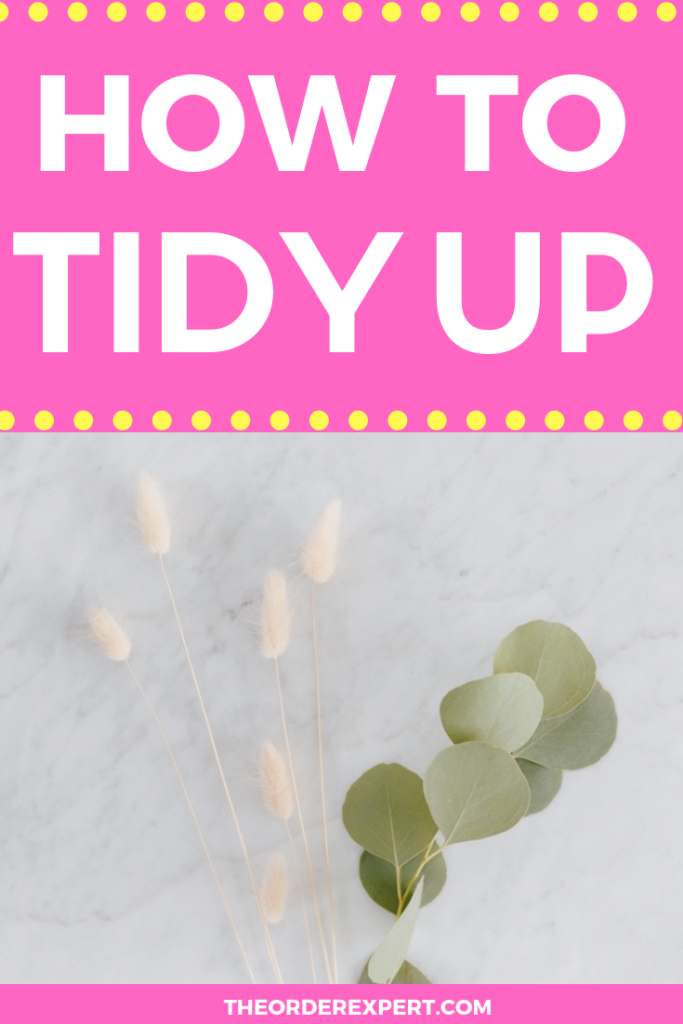
Are you looking to tidy up your home or office?
Have you ever wondered if there’s more than one way to tidy up a space?
You may not have thought about it, but the phrase “tidy up” has several meanings.
What one person considers to be tidying up can mean a different thing to someone else.
What’s more, the phrase can be interpreted as something completely different to another person.
With so many different variations when it comes to tidying up a space, it’s no wonder how things can quickly become confusing!
So, what’s the best way to go about tidying up a space?
It all begins with identifying exactly how you want to tidy up a space.
Once you’ve defined the exact steps you want to take, why your work will go much, much smoother.
In this post, you’ll find some thoughtful tips to help you tidy up a home, office, or pretty much any type of living space.
Whether you choose one approach or another, make sure you’ve fully defined the steps you want to take in your work.
So, are you ready to get started?
Let’s begin!
Tidy Up: Which Approach are You Going to Take?
When it comes to tidying up your space, which approach are you going to take?
Now, this may come as a complete surprise: you might not have even realized there are different ways to tidy up a space!
As I mentioned earlier, what one person considers as tidying up can mean something completely different to someone else.
Let’s quickly review a few of the most common tidy up approaches:
- Declutter items
- Return items to their storage location
- Make items neat and orderly
For the most, whenever you tidy up items, you’re probably going to be following one of the approaches above.
Sound good? Let’s now define each of these tidy up approaches further, one by one.
Tidy Up Approach #1: Declutter items
This first tidy up approach is all about reducing and removing items from one’s home or office. This approach is otherwise commonly known as decluttering.
Decluttering is the process of removing items you no longer need, want, use, or like in your life. Now, you may not believe this, but I’ll say it here in black and white so it is perfectly clear: it is 100% okay to remove items from your life on a regular basis.
Removing items from your personal space is a normal part of life. You can’t be expected (nor would you want to try!) to cart around every single possession or item you’ve ever touched, purchased, or used over the course of your life.
Letting go of items you’ve outgrown frees up both physical and mental space. You have more useable space in which to live and work, plus, your mind isn’t constantly bombarded by piles of clutter and miscellaneous items.
What’s more, the process of decluttering allows you to move forward into the future and experience new places, environments, items, and relationships.
Here are some tips to help you with your decluttering work:
Declutter frequently used areas.
Make it a point to declutter areas in your home or office that are disruptive to your normal routine.
If you’re always pushing through mounds of clothing you never wear in your bedroom, knocking over stacks of magazines in your hallway that no longer interest you, or struggling to find the toothpaste on the bathroom counter every morning, well, something has to give.
You’ll want to turn your attention to decluttering these troublesome areas sooner, rather than later. You don’t have to tackle every single area all at once: just choose one small area, and get to work.
With just a little bit of effort now, you’ll be able to regain full and proper use of your living space in future.
Start by removing trash and damaged items.
An easy way to get started with the decluttering process is to remove obvious trash and damaged items. You don’t want these items cluttering up your living and work spaces if you can help it.
You should appropriately throw out or recycle items that are obviously worn, damaged, broken, expired, or defective. Be sure to have a trash bag or bin on hand to make it easy to dispose of or recycle items.
Declutter items you no longer need, use, or like.
The next step in the process is to remove items you no longer need, use, or like. Remember, you only have a finite amount of space in your home and work spaces.
Which items are you going to keep: and which are you going to let go of? The more honest you can be with yourself during this process, the better.
Here’s several decluttering questions to help you with the process:
- When was the last time I used this item?
- Am I holding onto this item for practical or sentimental reasons?
- Will I truly use this item on a regular basis?
- Am I holding on to this item “just in case”?
- Am I holding onto this item just because it was a gift?
- Do I enjoy using this item?
- Does this item help make my home beautiful, warm, and welcoming?
Tidy Up Approach #1 Additional Resources
- How to Declutter Your Home
- How to Declutter Your Life
- 10 Practical Decluttering Tips to Try Today
- 23 Decluttering Questions to Ask Yourself at Home
- 100+ Items to Declutter at Home
Tidy Up Approach #2: Return items to their storage location
This second tidy up approach is one where you return items back to their designated storage location when you are finished using said items. This approach assumes you’ve already designed specific areas or storage locations for items.
You’d be amazed at how neat and tidy a space can be when you take the time to return items back to where they belong in a home or workspace. It really is as simple as picking up an item, and returning it appropriately to a shelf, cabinet, drawer, corner, or room.
Now, if it really is so easy to keep things in order, where do things go wrong? Usually, this is because of one or two main issues: 1) items aren’t promptly returned to their proper storage location, and 2) there isn’t a designated storage location for items.
Here are some tips to help you return items to their storage location and designate storage locations:
Return items to their storage location as soon as possible.
Get in the habit of returning items to their proper storage location as soon as possible.
The longer you wait to move an item, the less likely it will be moved to it’s designated storage location.
Ideally, you should return an item to it’s storage location right after you’ve finished using it.
So, don’t wait another moment longer: return that screwdriver to the toolbox, put those books back on the bookshelf, and place those files back in the filing cabinet.
Be mindful when handling and using items.
One of the keys to keeping a space neat and tidy is to be generally aware of the contents sitting in a room at any given point in time.
Now, this isn’t about necessarily cataloging every single item you own, but it’s about being aware of which items belong in a particular room…and then returning items to their proper storage locations.
Practice being mindful of items on a regular basis. For instance, if you see a stack of notes and books sitting on your kitchen table after an afternoon study session, you’d probably want to return these times to your desk, backpack, or bookcase.
Likewise, if you find a pile of clean clothes in the laundry room, you’d probably want to return the clothes to your closet or clothes dresser for future use.
Choose practical storage locations for items.
When it comes to finding a practical storage location for an item, consider how often you’ll use said item.
If you use an item frequently, say every day or every week, you’ll probably want to store the item in an easy to reach location and in the same room in which you use the item.
Opt for an easy-to-access location, be it a nearby drawer, shelf, countertop, closet, hutch, or cabinet.
If you use an item infrequently, such as seasonally or once or twice every year, you’ll most likely want to store the item in dead storage, archives, or other out-of-the-way location.
This will keep the item safe and out of your way for most of the year.
Consider storage locations for new items before purchasing items.
Thinking about buying a new item for your home or office?
Take a few minutes to think about where you will store the item in future. You may want to walk over to potential storage locations to see if you truly have enough space in which to store something.
Don’t have enough room? Consider doing a thorough round of decluttering in the immediate area, or consider relocating or moving items in the that space to other areas of your home, accordingly.
Tidy Up Approach #2 Additional Resources
- How to Be an Organized Person
- How to Stay Organized By Writing Yourself Notes
- 9 Easy Ways to Be More Organized Today
- 3 Thoughtful Ways to Be More Organized
- 8 Common Myths About Being Organized
Tidy Up Approach #3: Make items neat and orderly
This third tidy up approach is all about making items look neat and orderly. This approach is slightly different from the previous two in that it requires you to carefully arrange items together so they look neat, tidy, and in order.
You don’t need any special tools for this approach, nor do you need to be a whiz at organizing or design. You just need to be willing to collect and arrange items in such a way that is streamlined or pleasing to the eye.
Still having trouble understanding this approach? Don’t worry! You’ve probably seen many examples of this in action, but hadn’t realized what you were looking at.
Here’s a few examples of how you can make items look neat and orderly at home:
- Make a bed (or two)
- Arrange books and magazines neatly into a pile or on a bookshelf
- Fully close and secure a cabinet door or drawer
- Line up decorative pillows neatly on a sofa
- Push chairs in all the way at a dining room or kitchen table
- Assemble cooking utensils and spices neatly on a rack or shelf
See how easy this is?
Now that you’ve got a better idea as to what we mean by making items neat and orderly, let’s get you well on your way…
Here are some tips to help you make items neat and orderly:
Tidy up your space on a regular basis.
You don’t have to spend hours tidying up a space.
In fact, spending a few minutes spent tidying up over the course of a week may very well save you from hours of work in a months’ time. It doesn’t matter so much as when you tidy up, so long as you do so on a regular basis.
Try tidying up after you’ve finished working at your desk, after cooking or eating a meal in the kitchen or dining room, as soon as you wake up in the morning, or before settling down for the evening.
Try squaring off piles of items.
An easy way to make things look neat and tidy is simply square of stacks or piles of items. All you have to do is carefully stack items on top of one another in short pile in a neat fashion.
Keep in mind, this shouldn’t be a long-term or permanent solution for organizing items. This is just a general way to make items look neat and tidy in a short period of time.
Practice organizing like items with like.
Another simple way to make things look neat and tidy is to organize like items with like. All you have to do is gather similar items with one another and place them in the same location or area.
For example, do have a bunch of books strewn about a room? Gather and store them in a bookcase. Are those pens and pencils getting out of hand on the top of your desk? Collect all writing implements and place in a pen cup, pencil case, or desk drawer trough.
Tidy Up Approach #3 Additional Resources
- How to Keep Things Neat
- 7 Quick Tips to Keep Things Tidy
- 40 Thoughtful Ways to Organize Items
- How to Organize: A Step-By-Step Guide
- Want to Have a Productive Day? Try Making Your Bed in the Morning
How about you? How do you use the phrase ‘tidy up?’ Which of the following methods are you going to use when you tidy up a space? Join the conversation and leave a comment below!






0 Comments